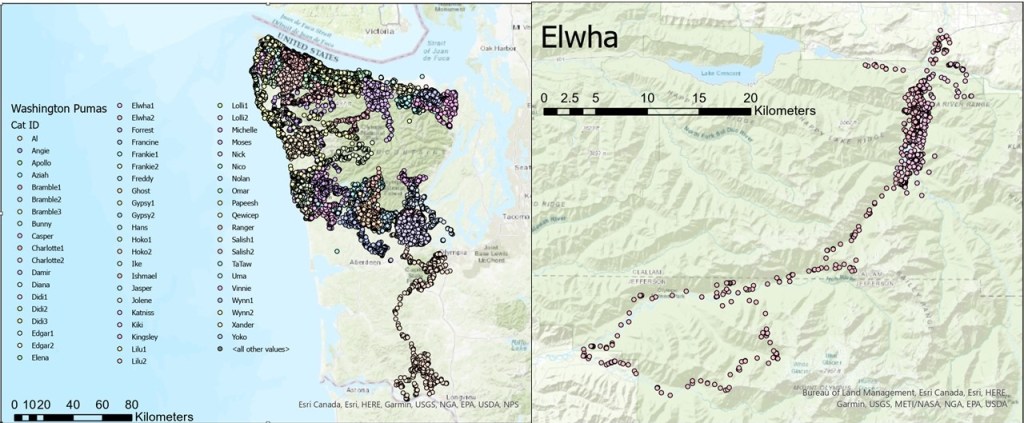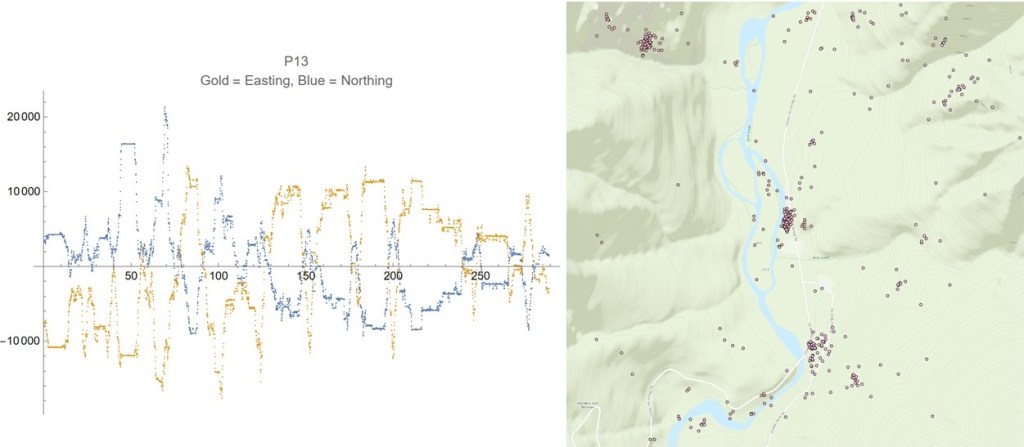Post provided by Mark Elbroch, Chaoran Hu, Tom Meyer, Vladimir Pozdnyakov & Jun Yan
Information on how and even why terrestrial mammals move through their habitat landscapes is important for forming the foundation of how to manage and conserve species. For elusive mountain lions, GPS data is particularly vital for monitoring these important apex predators in relation to their ecosystems and the people they share the land with. In this blog post, the team discusses their novel motion model, published in Methods in Ecology and Evolution, which helps us understand the movement of mountain lions from GPS location data.
Bears, wolves, and mountain lions are the apex mammalian carnivores in the United States and Canada. The well-being of the apex-carnivore populations has a strong influence on the health of the entire ecosystem in which they live through a process known as a trophic cascade. This is where the apex carnivores control the populations of the myriads of herbivores that, if left uncontrolled, would overpopulate and devastate the vegetation in their environment through overgrazing. This overgrazing leads to soil erosion and species reductions, and to starvation of the herbivores after they have depleted their environment of their own food source.
Gathering movement data on apex carnivores is key to managing the environment in which we all live. The conservation movement in the United States has made progress in restoring the populations of apex carnivores resulting in forest regrowth and reductions in soil loss from erosion because the populations of rodents and ungulates is being better managed by the carnivores, which gives the herbaceous vegetation a better chance to reseed, which enriches the soil and allows the vegetation grow better.
GPS and animal movement
Understanding how animals use the space in which they live is fundamental to managing these species. Modern positioning technologies, such as the Global Positioning System (GPS), have revolutionized our ability to monitor, and then understand, how these animals use the landscape. GPS receivers have become small enough to attach to a collar that is fitted on an animal while the animal is sedated. The GPS then transmits position, and sometimes other movement data (e.g., accelerometry), back to researchers in their offices via satellite phones. In this way, the animal is minimally disturbed, and researchers get to “watch” the animal go about its business either until the end of the batteries or of the animal itself. Our research focuses on pumas, also known as mountain lions and as cougars.

We visualize the GPS data in a geographic information system (GIS).Being able to easily combine map layers and subset the data according to the attribute information gathered in situ by Dr. Elbroch is invaluable. Plotting the GPS positions’ easting and northing coordinates over time reveals an interesting quality of these data. The trajectories of P13, ‘Elwha’ (below) generally look like Brownian Motion, but two distinct movement patterns are evident. There are many “plateaus” in the data when she stayed, more or less, in the same place for extended periods. It is well known that big cats spend much of their time asleep, and it is also well known that they will occupy a kill site either until they have consumed the carcass, which can take the better part of a week, or they get driven off the kill by dominant carnivores like wolves or grizzly bears. We generically call these periods when the puma is not moving, for whatever reason, “resting” periods. When the puma is not in a resting period, it is moving. In the GIS, the resting periods form point clusters, which can be seen in the right panel, which is a zoomed-in view of Elwha’s trajectory.

Moving-Resting Process (MR) model
Understanding the moving-resting nature of puma data lays at the heart of understanding how, and even why, these animals go where they go and do what they do. With this motivation, our team built a stochastic process model, moving-resting process (MR), in which the holding times in the moving stage and the resting stage are exponentially distributed, and the moving stage is modeled by a Brownian motion. This model was first proposed in Yan et al (2014), but the measurement errors from the telemetric or GPS devices are not satisfactorily handled until our recent paper in Methods in Ecology and Evolution, which presents a solid and practical inference process for the moving-resting model with measurement errors (MRME). Both MR and MRME models are implemented and ready for use in R package smam, that can be reached from both CRAN and GitHub. This package also includes implementations of other three related models:
- Brownian motion with measurement error (BMME) models animal movement by Brownian motion only with measurement error modelled by added Gaussian noise.
- Moving-resting-handling (MRH) process models animal movement with three states: moving, resting, and handling. This model assumes the animal always switches from a motionless state to the moving state. But when an animal switches from the moving state, it may end with resting or handling.
- Moving-moving (MM) process modified the moving-resting process by replacing the resting state with a second moving state with a relatively lower mobility.
Summary
These models, as part of our smam R package, enable ecologists to understand how seasons and hunting pressure affect puma movement and their behavior, reveal differences between the sexes, and even inter-species interactions. These models allow us to create new home-range models for the lions that are based on rigorous statistical distributions instead of ad hoc models, like convex hulls. Our current research is examining how seasons and hunting pressure affect (or not) the movement behavior of the pumas, which should provide valuable insights for future management.
To read the full Methods in Ecology and Evolution article, click on the following link: Moving-resting process with measurement error in animal movement modeling.
For the full details on the smam R Package, visit CRAN or GitHub.



